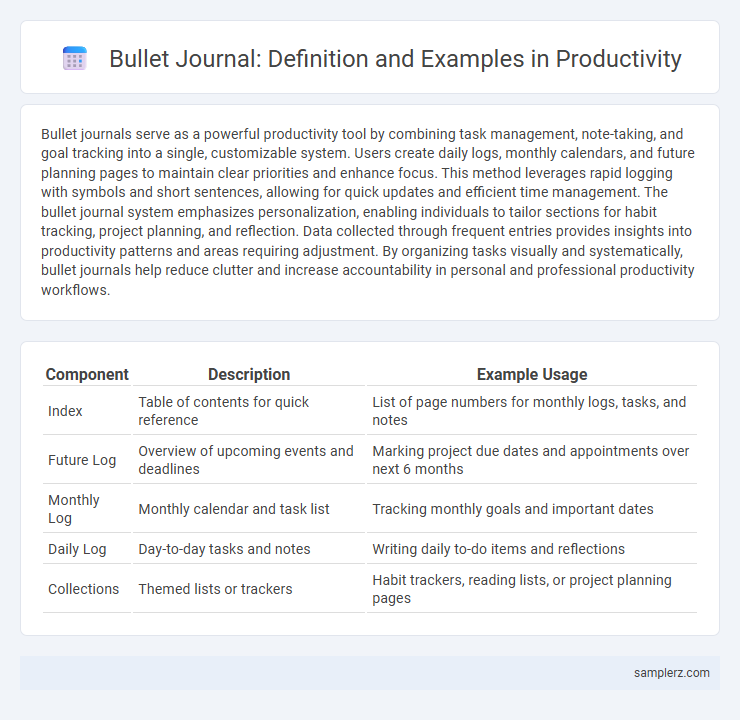Bullet journals serve as a powerful productivity tool by combining task management, note-taking, and goal tracking into a single, customizable system. Users create daily logs, monthly calendars, and future planning pages to maintain clear priorities and enhance focus. This method leverages rapid logging with symbols and short sentences, allowing for quick updates and efficient time management. The bullet journal system emphasizes personalization, enabling individuals to tailor sections for habit tracking, project planning, and reflection. Data collected through frequent entries provides insights into productivity patterns and areas requiring adjustment. By organizing tasks visually and systematically, bullet journals help reduce clutter and increase accountability in personal and professional productivity workflows.
Table of Comparison
| Component | Description | Example Usage |
|---|---|---|
| Index | Table of contents for quick reference | List of page numbers for monthly logs, tasks, and notes |
| Future Log | Overview of upcoming events and deadlines | Marking project due dates and appointments over next 6 months |
| Monthly Log | Monthly calendar and task list | Tracking monthly goals and important dates |
| Daily Log | Day-to-day tasks and notes | Writing daily to-do items and reflections |
| Collections | Themed lists or trackers | Habit trackers, reading lists, or project planning pages |
Introduction to Bullet Journaling for Productivity
Bullet journaling organizes tasks, goals, and ideas into a flexible, customizable system that boosts productivity by combining planning, tracking, and reflection. Using indexed logs, rapid logging, and collections, users efficiently prioritize tasks and monitor progress across daily, weekly, and monthly spreads. This increase in mindfulness and structure reduces overwhelm and enhances focus, making bullet journals a powerful tool for personal and professional productivity.
Key Bullet Journal Components to Boost Productivity
Key bullet journal components that boost productivity include an index for easy navigation, daily logs to track tasks and appointments, and habit trackers to monitor progress over time. Collections such as project plans and goal lists help prioritize important activities and maintain focus. Using rapid logging with symbols like bullets, dashes, and asterisks streamlines task management and enhances efficiency.
Daily Log Examples for Effective Task Management
Bullet journals enhance productivity by organizing daily logs that prioritize tasks, appointments, and notes efficiently. Examples include using time-blocking segments, task migration symbols, and habit trackers to monitor progress and maintain focus. Employing clear headers and bullet points streamlines task management, resulting in increased accountability and reduced procrastination.
Weekly Spread Ideas for Improved Planning
Bullet journal weekly spreads enhance productivity by organizing tasks, events, and goals in a clear, visual format that boosts time management and focus. Incorporating habit trackers, priority lists, and space for reflections helps users monitor progress and adjust plans dynamically. Customizable layouts such as time-blocking grids and weekly goals sections optimize workflow and reduce stress by providing a structured yet flexible planning system.
Monthly Overview Layouts to Track Progress
Bullet journals enhance productivity by providing customizable Monthly Overview Layouts that allow users to track progress efficiently. These layouts typically include habit trackers, goal summaries, and key deadlines, enabling a clear visual representation of achievements and areas needing improvement. Using a bullet journal's Monthly Overview Layout helps maintain focus, prioritize tasks, and measure productivity growth over time.
Habit Tracker Examples for Building Productive Routines
Bullet journals serve as an effective productivity tool through habit trackers that visually map daily habits, fostering consistency and accountability. Examples include tracking water intake, exercise frequency, and reading time, which helps individuals identify patterns and make data-driven adjustments to enhance routines. Integrating color-coded symbols and progress bars increases engagement and motivation to maintain productive habits over time.
Goal Setting Pages: How Bullet Journals Foster Achievement
Goal setting pages in bullet journals enhance productivity by providing a structured space to outline, track, and prioritize objectives clearly. These pages incorporate customized layouts such as monthly goals, habit trackers, and milestone checklists, which facilitate consistent progress monitoring. The tactile engagement of writing goals promotes mindfulness, increasing accountability and the likelihood of achievement.
Project Planner Spreads to Streamline Workflow
Bullet journal project planner spreads organize tasks, deadlines, and milestones in a visually structured layout, enhancing focus and time management. Using color-coded symbols and priority indicators, these spreads enable efficient tracking of project progress and resource allocation. Integrating daily logs with project overviews reduces task overlap and ensures streamlined workflow execution.
Time Management with Bullet Journaling Techniques
Bullet journaling enhances time management by allowing users to customize task lists, daily logs, and monthly calendars, promoting focused prioritization and efficient scheduling. Techniques such as rapid logging and time blocking streamline task tracking while minimizing distractions. This system improves accountability and reduces procrastination, boosting overall productivity.
Customization Tips for Enhancing Bullet Journal Productivity
Bullet journals boost productivity through tailored customization, such as integrating habit trackers to monitor daily routines and prioritize tasks effectively. Utilizing color-coded symbols and layouts enhances visual organization, making it easier to identify urgent activities and deadlines at a glance. Incorporating modular sections like monthly goals, weekly reflections, and productivity logs refines task management and sustains motivation throughout projects.

example of **bullet journal** in **productivity** Infographic
 samplerz.com
samplerz.com